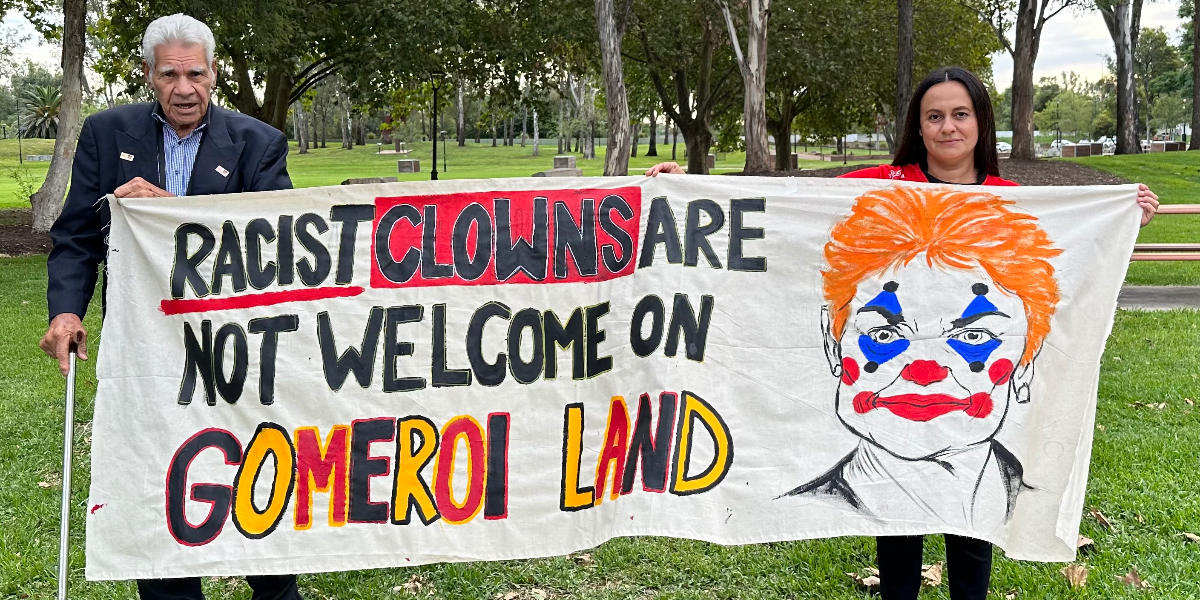In a further sign that Member for New England Barnaby Joyce is out of step with his electorate, his formal launch for the campaign against the Indigenous voice to Parliament only attracted a modest crowd of mostly older people in Tamworth last night.
The first formal launch for one of the many ‘no vote’ campaigns, ‘Recognise a Better Way’, the event was also headlined by Senator Pauline Hanson, broadcaster Alan Jones, and former Labor Minister Gary Johns. Around 200 people attended the event, including journalists and protestors, leaving much of the hall empty. At full capacity the Tamworth War Memorial Town Hall can seat 1000 people. The modest crowd of predominantly white-haired people were all clustered in a block to make for a better crowd shot as the event was aired on the Jones-owned internet TV channel ADH.
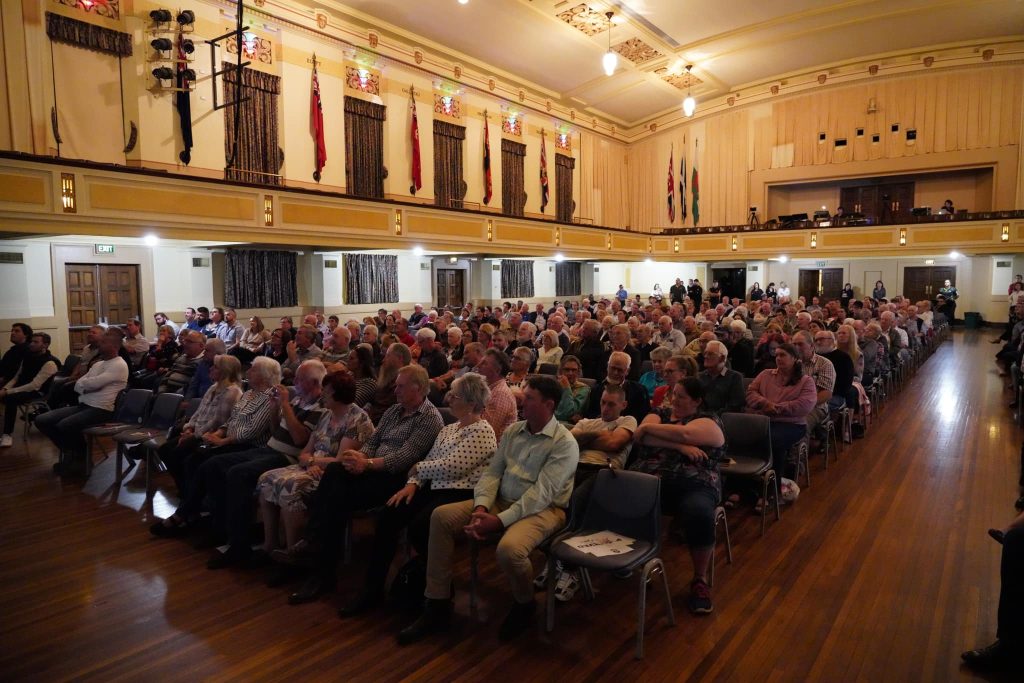
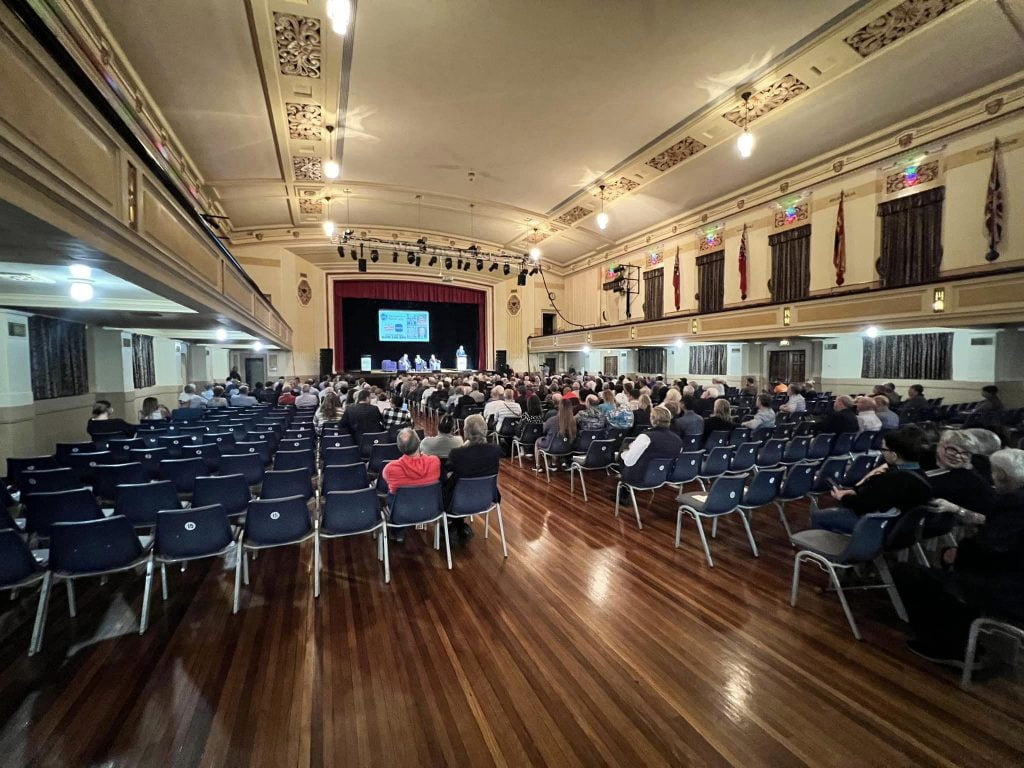
Left: the scene from the Tamworth event as shared by Pauline Hanson on her Facebook page; Right: what the room looked like from the back, showing the empty seats and crowd clustered towards one side (photo: Marc Sutherland).
The ‘Recognise a Better Way’ campaign argues that the Voice is a distraction from achieving real, practical, and positive outcomes for Aboriginal and Torres Strait Islander Australians. They argue that issues like poverty and disadvantage is not caused by lack of voice, but rather a lack of economic participation. Their alternative proposal is to completely disregard the Uluru Voice from the Heart and instead recognise the prior occupation of Aboriginal people in a preamble to the constitution, establish a parliamentary standing committee for native title holders, and support Aboriginal community-controlled organisations.
The group claims that the Uluru Statement from the Heart was developed by a very small group of Aboriginal people, and presented to 250 delegates at a convention event funded by the Government. The first of three papers they intend to release on the issue is extremely dismissive of the Uluru process, stating “voters may regard the Uluru Statement as no more than an ambit claim”.
The document repeatedly asserts that the ‘Voice, Treaty, Truth’ agenda is the Prime Minister’s personal model. The document does not explain how, exactly, Anthony Albanese inserted “his model” into a proposal two years before he became opposition leader, five years before he became Prime Minister, and during the last Coalition Government. Social media posts also repeatedly refer to it being “Labor’s Voice to Parliament”.
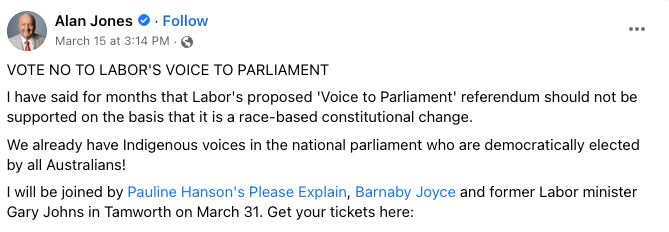
Barnaby Joyce’s opposition, as laid out in a statement on March 23, seems to be more narrowly focused on the Voice having the power to go to the high court to have legislation struck out if they were not consulted. Like many of the claims of the campaign, this also appears to be without basis. The Prime Minister and other have repeatedly stated that the Voice would not, in any way, supplant the parliament’s role as decision maker. The wording of the question is extremely vague as to what exactly the Voice can and can’t do, only that there will be an Aboriginal and Torres Strait Islander Voice.
A Proposed Law: To alter the Constitution to recognise the First Peoples of Australia by establishing an Aboriginal and Torres Strait Islander Voice. Do you approve this proposed alteration?
The precise wording of the planned Voice referendum question to be put to voters later this year
Despite his formal statement, his comments at the event, and in social media posts, were far more racist and claimed it would be putting race in to the constitution, which would be a backwards step. (Race has been in the constitution since 1901.)
The event may be able to blame the lack of attendance on the poor promotion of the event, but there were plenty of critical voices too. Armidale Regional Council member and Anaiwan man Brad Widders posted on Facebook critical of the event, calling the speakers “perpetual nincompoops looking to make everything into culture wars”. Like many Indigenous leaders, Widders has been consistent in not telling people how to vote in the referendum, only telling them to read all the information and make an informed decision.
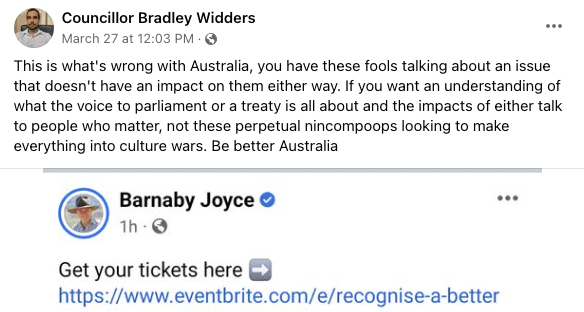
Many comments from other locals around the region were less polite. “A roadshow of obnoxious white privilege,” said one New England woman. “I have been seething about this all week,” wrote another. “There were so many misleading, hurtful statements – fact-checker needed!” said a Tamworth man who attended the event.
A group of Gomeroi women also formally protested the event, describing the speakers as racists who are not welcome on their country. In a statement, respected Gomeroi yinnar Amy Hammond, Lorrelle Munro, Bronwyn Spearim, Emily Honess, Sophie Honess, Rachael Phillips, and Amy Creighton said they were not advocating for or against the Voice, but rather speaking out about the real-life impact of allowing racists to have platforms and the danger of spreading misinformation.
“We categorically refuse to have racists on our country. We will not allow them to inflame intense racial tensions with discriminatory and exclusionary messages. These speakers have large followings and a legacy of racist rhetoric that creates environments for racially fuelled violence. We refuse to allow this to occur in Gomeroi country.”
“Barnaby Joyce, Pauline Hanson, and Alan Jones have a long history of promoting discriminatory and exclusionary messages. Their words have real-life consequences and contribute to the ongoing racism faced by First Nations people in this country. We believe everyone is responsible for speaking out against racism, and we call on all Australians to join us.”
The referendum on the Voice to Parliament will be held later this year. Multiple events presenting both the Yes and No cases are expected to be held in coming months.
Top image: protestors from the event (supplied by Gomeroi Yinnar community)
Like what you’re reading? Support New England Times by making a small contribution today and help us keep delivering local news paywall-free. Support now


